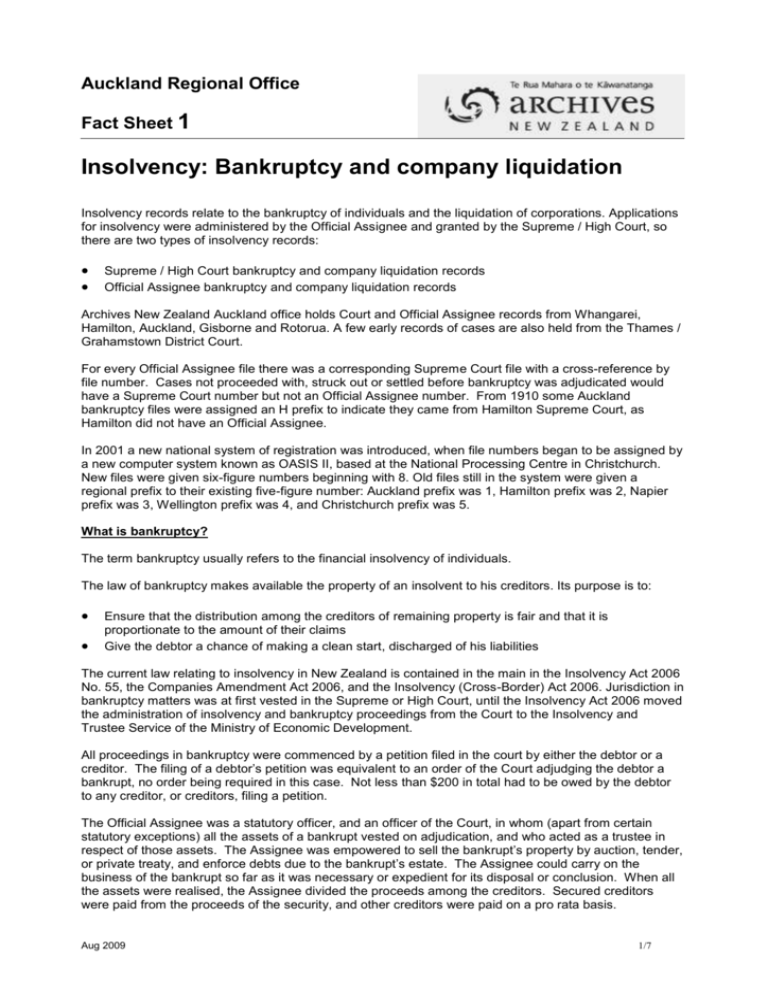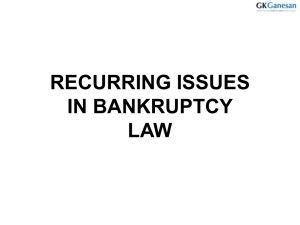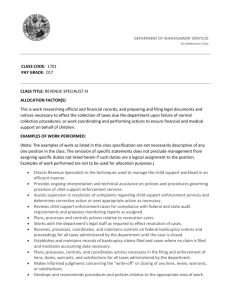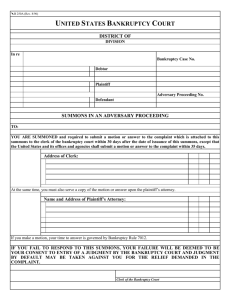Auckland Regional Office Fact Sheet 1
advertisement

Auckland Regional Office Fact Sheet 1 Insolvency: Bankruptcy and company liquidation Insolvency records relate to the bankruptcy of individuals and the liquidation of corporations. Applications for insolvency were administered by the Official Assignee and granted by the Supreme / High Court, so there are two types of insolvency records: Supreme / High Court bankruptcy and company liquidation records Official Assignee bankruptcy and company liquidation records Archives New Zealand Auckland office holds Court and Official Assignee records from Whangarei, Hamilton, Auckland, Gisborne and Rotorua. A few early records of cases are also held from the Thames / Grahamstown District Court. For every Official Assignee file there was a corresponding Supreme Court file with a cross-reference by file number. Cases not proceeded with, struck out or settled before bankruptcy was adjudicated would have a Supreme Court number but not an Official Assignee number. From 1910 some Auckland bankruptcy files were assigned an H prefix to indicate they came from Hamilton Supreme Court, as Hamilton did not have an Official Assignee. In 2001 a new national system of registration was introduced, when file numbers began to be assigned by a new computer system known as OASIS II, based at the National Processing Centre in Christchurch. New files were given six-figure numbers beginning with 8. Old files still in the system were given a regional prefix to their existing five-figure number: Auckland prefix was 1, Hamilton prefix was 2, Napier prefix was 3, Wellington prefix was 4, and Christchurch prefix was 5. What is bankruptcy? The term bankruptcy usually refers to the financial insolvency of individuals. The law of bankruptcy makes available the property of an insolvent to his creditors. Its purpose is to: Ensure that the distribution among the creditors of remaining property is fair and that it is proportionate to the amount of their claims Give the debtor a chance of making a clean start, discharged of his liabilities The current law relating to insolvency in New Zealand is contained in the main in the Insolvency Act 2006 No. 55, the Companies Amendment Act 2006, and the Insolvency (Cross-Border) Act 2006. Jurisdiction in bankruptcy matters was at first vested in the Supreme or High Court, until the Insolvency Act 2006 moved the administration of insolvency and bankruptcy proceedings from the Court to the Insolvency and Trustee Service of the Ministry of Economic Development. All proceedings in bankruptcy were commenced by a petition filed in the court by either the debtor or a creditor. The filing of a debtor’s petition was equivalent to an order of the Court adjudging the debtor a bankrupt, no order being required in this case. Not less than $200 in total had to be owed by the debtor to any creditor, or creditors, filing a petition. The Official Assignee was a statutory officer, and an officer of the Court, in whom (apart from certain statutory exceptions) all the assets of a bankrupt vested on adjudication, and who acted as a trustee in respect of those assets. The Assignee was empowered to sell the bankrupt’s property by auction, tender, or private treaty, and enforce debts due to the bankrupt’s estate. The Assignee could carry on the business of the bankrupt so far as it was necessary or expedient for its disposal or conclusion. When all the assets were realised, the Assignee divided the proceeds among the creditors. Secured creditors were paid from the proceeds of the security, and other creditors were paid on a pro rata basis. Aug 2009 1/7 Creditors could accept a composition in satisfaction of the debts due to them. In such a case, after approval of the Court, a deed of composition was executed and filed, and the bankruptcy annulled. Upon application being made by the bankrupt, the court was empowered to grant an order of discharge, which could be absolute, conditional, or suspended. The application could be opposed by the assignee, or by any creditor whose claim had been proved, and public examination of the bankrupt could be demanded. In all other cases a person adjudged bankrupt was automatically discharged three years after adjudication, in the absence of any earlier application by the bankrupt or an objection lodged by the Assignee or a creditor with the Court. Where an objection to discharge was lodged, the Court determined whether a discharge should be granted. Where a creditor was concerned that a bankrupt could realise the assets and depart, without regard for any financial obligations, application could be made under the Insolvency Act 1967 for the assignee to be appointed as a receiver/manager of the property prior to the hearing of the creditor’s petition. The Insolvency Act of 2006 introduced an alternative to bankruptcy known as a “no-assets procedure”, and also introduced voluntary administration for companies as an alternative to liquidation. Sources: New Zealand Government Yearbook 1990 New Zealand Government Yearbook 1996 Ministry of Economic Development Insolvency and Trustee Services website, retrieved 5 March 2009 from: http://www.insolvency.govt.nz/cms Information contained in bankruptcy files Supreme Court - Order for bankrupt’s discharge, motion for discharge of bankrupt, affidavit by bankrupt in support of application for discharge, motion for assignee’s release, statement of accounts and balance sheet with the Audit Office report thereon, debtor’s petition, report of assignee and order of release Official Assignee - Notice of adjudication schedule, statement of bankrupt, list of unsecured creditors, liabilities, real estate, statement of bankrupts’ affairs, report of the assignee, claimants’ letters to Official Assignee, promissory notes, proofs of debt Details recorded in the Bankruptcy Registers include: Office Number (Official Assignees Single running file number) Date of Adjudication Name Supreme Court File Number (B for Bankruptcy or M for Miscellaneous) Date of Discharge Date of Release (Early registers include occupation and address). Details recorded in the Registers of Proof of Debt Registers include: Name File Number Date of Receipt Creditor’s Name Occupation Address Preferential Claim Ordinary Claim First Dividend Third Dividend Details in Assets and Claims Registers include: Claim Number Claim Amount Claimant Aug 2009 2/7 Nature of Claim Preferential Claims and Date Paid Preferential Claims and Amount Paid Amount Ordinary Claim Submitted First Dividend and Amount Paid Estate of File Number Value of Bankrupts Statement Number of Assets How disposed Amount Realised Amount Irrecoverable Debt and Bankruptcies: A Brief Historical Overview The Court of Requests Ordinance 1841 instituted a Court of Requests to deal with the recovery of small debts. Bailiffs were appointed to levy on the debtor’s goods, and if unable to find any “enforce the judgement of the Court by personal imprisonment of the Defendant” who could then be detained in jail for up to three months. Large debts were dealt with by the Supreme Court under the Supreme Court Rules, 1844. The Imprisonment for Debt Ordinance 1844 allowed the debtor who had remained in prison for two months or longer to apply for his release. His petition, which also gave details of his debts and named the creditors of whose unit he was detailed, was filed in the Supreme Court. The Debtors and Creditors Act 1862 instituted the calling of creditors meetings where proposals for the winding up the debtor’s estate could be made. A trustee to hold the debtor’s estate and effects was also appointed. Under Supreme Court Supervision the estate was wound up and the debtor discharged. Notices listing petitions of persons applying for relief were published in Provincial Gazettes, as were Court Orders made as each case progressed. From late 1864 some court orders were published in the New Zealand Gazette. The Bankruptcy Act 1867 provided for the appointment of an Accountant in Bankruptcy who was required to publish in the New Zealand Gazette returns by districts of bankrupt estates from the past year and those remaining from previous years since the Act. These were published between 1869 and 1872. The Resident Magistrates Act 1867 provided for the abolition of imprisonment for debts of less than £10. The Imprisonment for Debt Abolition Act 1874 abolished imprisonment for all debts except those involved in “quasi criminal activity”, mainly defaulting in payment of Court Orders relating to debt. In effect these legislative changes meant that debtors, for whom imprisonment would once have been inevitable, were able to avoid arrest by filing for bankruptcy. Under the Debtors and Creditors Act 1876, when all of the property of the debtor had been realised and dividends paid, the trustees filed in the Court a report, balance sheet and statement. Similar procedures were followed under succeeding Acts. Until 1883 responsibility for management of bankrupt estate had rested variously with the creditors, an appointed trustee or Court Registrar. The Bankruptcy Act 1883 provided for government appointed Official Assignees. At first the Official Assignees kept individual Minute-Books of proceedings of each estate which in time gave way to files. The Bankruptcy Act 1883 was succeeded in turn by those of 1892, 1908 (and amendments), the Insolvency Act of 1967, and the current Insolvency Act of 2006. Aug 2009 3/7 Annual lists of those bankrupts remaining undischarged since 1 April 1927 were published in the New Zealand Gazette from 1928 to 1936. A further list was published in 1964. Creditors meetings were advertised in the local newspapers and from 1893, in the New Zealand Gazette. The Mercantile Gazette first published in 1876 also listed names of persons who became bankrupt. Sources: Hampton, Denis (1990) Imprisonment for Debt, The New Zealand Genealogist 21 No.205 September / October 1990 pp.210-211 Bankruptcy and its Records. New Zealand Genealogist 22 No.207 January / February 1991 pages 6-11. Recovery of Debts The first step for suing for debt in a Magistrates/District court was for the plaintiff to serve the defendant a Default Summons. If the case went to court a Civil case file was kept and the Court judgement was placed on this. The first step in a Supreme/High Court action to recover a debt (or claims involving money) was the issuing of a Writ of Summons to the defendant. The writ was accompanied by a Statement of Claim. If the action went to Court an Action case file was kept and the Court decision/judgement was put on this. Writs of Sales record proceedings where money was recovered from defaulting debtors after judgement. [Sheriff] Warrants were issued to bailiffs to sell the goods of debtors to recover debts. They record details of parties involved, and the result. When a debtor failed to make the payments ordered by a Court, the Court judgement could be enforced by: The Court issuing a Court order, known as a Distress Warrant, for the defendant’s goods to be seized by bailiffs and sold to pay off the debt. The Court issuing an Attachment of Earnings Order. When an order was granted, the defendant’s employer was asked to deduct a fixed amount from the wages of the defendant. An attachment of earnings order could be made for a judgement of debt of any amount, but only if the debt was for income tax or maintenance. The Court issuing a Judgement Summons (over any judgement for debt) requiring the defendant to appear before the Court to explain why he had not paid. If he was earning or had enough money, a new order for payment was made against him. Alternatively he could be given a suspended sentence for contempt of court. The effect of the suspension of the sentence was that he stayed out of person only if he kept up the Court-ordered payments. Legislation relating to Debt The following list is not exhaustive. Imprisonment for Debt Ordinance 1844 Session III No.7 Imprisonment for Debt Ordinance Amendment Act 1861 No.8 Imprisonment for Debt Abolition Act 1874 No.14 Imprisonment for Debt Limitation Act 1908 Imprisonment for Debt Limitation Amendment Act 1989 Magistrates Court Rules 1948 Imprisonment for Debt (Magistrates Court Rules - SR 1949/188, 1952/243 and 1956/82) Details concerning debt can be found in the Judgement Summons Books for individual Magistrates Courts. If received from a Foreign Court they are entered in red in the Plaint Books. Aug 2009 4/7 Company Liquidation Liquidation (sometimes called ‘winding up’) was the legal process by which a company’s life was ended. The company’s assets were realised, its creditors paid out, any surplus distributed to the shareholders, and the company was then dissolved. Liquidation was carried out in accordance with the relevant provisions of the Companies Act 1955, the Companies (Winding Up) Rules 1956, (SR 1956/215) and the High Court rules, later amended by the Insolvency Act 2006, and the Companies Amendment Act 2006. The procedure was generally as follows: 1. The company passed a special resolution or the Court made an order for the company to be wound up, and a liquidator was appointed to control the company’s affairs. In a Court Order the Official Assignee was normally the liquidator. However, subsequent Court Orders could transfer the process of winding up a company to private liquidators. 2. The liquidator realised all the company’s assets, calls in (where relevant) as much of its uncalled capital as is necessary to meet its debts, and pays out the company’s creditors. If the realised assets and uncalled capital were not sufficient then the creditors were paid out according to the priorities set out in the Companies Act. 3. Any surplus remaining, after payment of liquidator’s expenses and all the creditors, was distributed to the company’s members in accordance with its memorandum and articles of association. 4. The company was then dissolved. Companies with heavy debt loads and cash-flow problems often had a receiver appointed over their assets, either by the court, or more usually under an express clause in a mortgage or debenture. Debentures usually contained a lengthy recital of the events which would enable debenture-holders to recover their loans if borrowers got into financial difficulties. One of these provisions would be the power of the debenture-holder to appoint a receiver. The usual reason for this was default in payment of principal and/or interest. It was also possible for a receiver to be appointed because of any other breach of the provisions of the debenture. The function of a receiver once appointed was to get in or realise the assets charged by the debenture, collect rents and profits, and exercise the debenture-holder’s powers of realisation, then pay the net proceeds to the debenture-holder in reduction of its charge. No property of the company was actually vested in the receiver, and, although the directors remained in office, the receiver superseded them and exercised their powers. The receiver’s status was one of agent rather than officer of the company. Control of the company was transferred to the receiver, but the appointment of a receiver did not terminate the company’s operations. Accordingly receivership was quite a distinct form of liquidation, as a receiver acted for the benefit only of the debenture-holder who appointed him or her. The Insolvency Act 2006 No.55 and the Companies Amendment Act 2006 introduced voluntary administration for companies as an alternative to liquidation. Sources: New Zealand Yearbook 1990, page 574 Ministry of Economic Development Insolvency and Trustee Services website, retrieved 5 March 2009 from: http://www.insolvency.govt.nz/cms Details concerning company liquidations can be found in the Official Assignee records and Supreme / High Court Miscellaneous Registers and Miscellaneous Files. The Official Assignee Auckland company liquidation files have a cross-reference to the file numbers of the Auckland Supreme Court files. From 1954 the Official Assignee also used a separate single number system which encompassed bankruptcy and company liquidation files. These form a single series (Archives New Zealand Auckland Series 5821). For other details concerning companies that have been voluntarily wound up or liquidated (i.e. closed companies) see the following Archives New Zealand, Auckland series: 5181 - Auckland closed company files - c.1860-1994; 21462 - registration files - c.1995-1999 10357 - Hamilton closed company files - 1900-1999; 21463 - registration files - c.1995-1999 5701 - Gisborne closed company files - 1883-1999 Aug 2009 5/7 Bankruptcy and Company Liquidation records held at Archives New Zealand, Auckland Regional Office: Access: Supreme / High Court - No restrictions for bankruptcy files, minute books or bankruptcy registers. Files not listed individually in Archway – search by name in registers to find file number. Official Assignee - 70 years restriction for bankruptcy files. No restriction for company liquidation files. Files listed individually in Archway. Official Assignee Whangarei Series Series name Date range 14394 Whangarei insolvency files 1964-1993 15040 Whangarei bankruptcy registers 1957-1990 18638 Whangarei single number insolvency files 1941-1963(1975) 10377 Official Assignee estate cash book 1919-1964 10378 Official Assignee commissions paid in respect of 1926-1958 bankrupt estate 10379 Official Assignee Estate Ledger 1932-1959 Whangarei insolvencies were included in the Auckland Registry from 1993 Restricted for 70 years 70 years 70 years No restrictions No restrictions No restrictions Official Assignee Auckland Series r Series name 11029 Alphabetical bankruptcy register 11030 Office bankruptcy registers 11031 Registers of proof of debt 11032 Assets and claims registers 11033 Ledger balances 11034 Cash books 11035 Unrealised assets A878 Creditors’ meeting minute books 11036 Estate ledgers 11037 Proof of debts registers 5821 Bankruptcy and company liquidation files 21460 Auckland insolvency files Date range 1884-1954 1954-1994 1909-1924 1906-1970 1918-1919 1924-1938 1926-1929 1909-1924 1908-1971 1921-1933 1954-2001 1886-1954 Restricted for No restrictions No restrictions No restrictions No restrictions No restrictions No restrictions No restrictions No restrictions No restrictions No restrictions 70 years 70 years Official Assignee Hamilton Series Series name 10050 Hamilton insolvency files 15474 Bankruptcy record book 15476 Bankruptcy ledger sheets Date range 1971-2001 1868-1987 1927-1966 Restricted for 70 years No restrictions No restrictions Official Assignee Rotorua Series r Series name 15468 Bankruptcy cash book 15477 Bankruptcy ledgers Date range 1967-1968 1959-1966 Restricted for No restrictions No restrictions Official Assignee Gisborne Series Series name 18337 Bankruptcy record book Date range 1954-1990 Restricted for No restrictions Whangarei Supreme / High Court Until 1937 Whangarei bankruptcy hearings were held at the Auckland Supreme Court Series Series name Date range 10308 Bankruptcy registers 1957-1993 10456 Bankruptcy files 1937-1994 10350 Registers of proof of debt 1919-1926 10347 Assets and claims registers [indexed] 1926-1939 Aug 2009 Restricted for No restrictions No restrictions No restrictions No restrictions 6/7 Auckland Supreme / High Court Series Series name 5631 Bankruptcy minute books 5639 Bankruptcy registers 5628 Bankruptcy files 18812 Bankruptcy indexes Miscellaneous register [company 4980 liquidations] Miscellaneous registers [company 4981 liquidations] Miscellaneous files [company liquidations] 4982 Miscellaneous files [company liquidations] 4983 5630 Attachment of debt register Date range 1873-1980 1887-1994 1886-1994 1992-1994 1884-1927 Restricted for No restrictions No restrictions No restrictions No restrictions No restrictions 1927-1986 No restrictions 1890-1926 1926-1985 1865-1875 No restrictions No restrictions No restrictions Date range 1870-1875 1885-1887 Restricted for No restrictions No restrictions Date range 1904-1909 1910-1966 1967-1976 1875-1966 1967-1979 1935-1939 Restricted for No restrictions No restrictions No restrictions No restrictions No restrictions No restrictions District Court Hamilton Series Series name 11258 Minute books, bankruptcy 4157 Bankruptcy register Date range 1880-1887 1904-1907 Restricted for No restrictions No restrictions Rotorua Supreme / High Court Series Series name 4989 Bankruptcy files 5088 Bankruptcy registers Date range 1973-1993 1973-1991 Restricted for No restrictions No restrictions Gisborne Supreme/High Court Series Series name 5826 Bankruptcy registers 5827 Annual number bankruptcy registers 5828 Bankruptcy files 5829 Annual number bankruptcy files 5842 Index to bankruptcy petitions Date range 1879-1969 1970-1986 1892-1969 1970-1991 c1890-1969 Restricted for No restrictions No restrictions No restrictions No restrictions No restrictions Thames [Grahamstown] District Court Series Series name 14471 Grahamstown bankruptcy cases 14551 Thames notebook of cases (bankruptcy) Hamilton Supreme / High Court Series Series name 4157 Hamilton bankruptcy register 4155 Hamilton bankruptcy registers 4156 Hamilton bankruptcy registers 17482 Hamilton bankruptcy files 17483 Hamilton bankruptcy files 11418 Application register for discharge of bankruptcy Aug 2009 7/7







